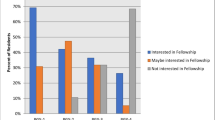Abstract
Objective
To evaluate how family practice-psychiatry residency programs meet the challenges of rigorous accreditation demands, clinical supervision and boundaries of practice.
Method
A 54-question survey of program directors of family practice-psychiatry residency programs outlining program demographic data, curricula, coordination, resident characteristics, integration, and overall satisfaction was mailed to 11 combined family practice psychiatry-residency programs.
Results
Programs surveyed were meeting residency review committee (RRC) requirements, and a majority of the program directors believe that the training is as good as or better than categorical programs, and categorical residents benefited from training alongside combined residents.
Conclusions
Training programs are growing in size and producing quality physicians.
Similar content being viewed by others
References
Chapman R, Nuovo J: Combined residency training in family practice and other specialties. Fam Med 1997; 29: 715–718
Doebbling CC, Pitkin AK, Malis R, et al: Combined internal medicine-psychiatry and family medicine-psychiatry training programs, 1999–2000: program directors perspectives. Acad Med 2001; 76: 1247–1252
Von Ammon CS, Elliott R: Future direction of psychiatric training for primary care physicians. Psychiatr Med 1988; 6: 64–86
Wulsin L, Cantor L: The current status of combined family practice and psychiatry residency programs. Fam Med 1999; 31: 606
Hartley D, Korsea N, Bird D, et al: Management of patients with depression by rural primary care practitioners. Arch Fam Med 1988; 7: 139–145
Katon W, VonKorff M, Lin E, et al: Collaborative management to achieve treatment guideline. JAMA 1995; 273: 1026
Regier DA, Narrow WE, Rae DS, et al: The De facto US mental and addictive disorders service system: epidemiologic catchment area prospective: one year prevalence rates of disorders and services. Arch Gen Psychiatry 1993; 50: 85–94
Sartorius N, Ustun TB, Lecrubiert Y, et al: Depression co-morbid with anxiety: results from the World Health Organization study on psychological disorder in primary health care. Br J Psychiatry 1996; 168: 38–43
Schulberg HC, McClelland M, Coulehan HL, et al: Psychiatric decision making in family practice: future research directions. Gen Hosp Psychiatry 1986; 8: 1–6
Thompson TL, Thomas MR: Teaching psychiatry to primary care internists. Gen Hosp Psychiatry 1985; 7: 210–213
Anfinson TJ, Bona JR: A health services perspective on delivery of psychiatric services in primary care including internal medicine. Med Clin North Am 2001; 85: 597–616
Goldberg D: Detection and assessment of emotional disorders in a primary care setting. Int J Ment Health 1979; 8: 30–48
Goldberg D, Steele JJ, Johnson A, Smith C: Ability of primary care physician to make accurate ratings of psychiatric symptoms. Arch Gen Psychiatry 1982; 39: 829–833
Jencks SF: Recognition of mental disorders and diagnosis of mental disorders in primary care. JAMA 1985; 253: 1903–1907
Jones LR: The Psychiatric Role of the Rural Primary Care Practitioner. Psychiatric Services for Underserviced Rural Population. New York, Burner/Mazel, 1985
Katon W, Rutter C, Ludman EJ, et al: A randomized trial of relapse prevention of depression in primary care. Arch Gen Psychiatry 2001; 58: 241–247
Marks JN: Determinants of the ability of general practitioners to detect psychiatric illness. Psychol Med 1979; 9: 337–353
Miller NS, Sheppard LM, Colenda CC, et al: Why physicians are unprepared to treat patients who have alcohol and drug related disorders. Acad Med 2001; 76: 410–418
Schulberg HC, McClelland M: A conceptual model for educating primary care providers in the diagnosis and treatment of depression. Gen Hosp Psychiatry 1987; 9: 1–10
Laufenburg HF, Turkal NW, Baumgardner DJ: Resident attrition from family practice residencies: United States versus international medical graduates. Fam Med 1994; 26: 614–617
Cochran A, Melby S, Foy HM, et al: The state of general surgery residency in the United States: program director perspectives, 2001. Arch Surg 2002; 137: 1262–1125
Author information
Authors and Affiliations
Corresponding author
Rights and permissions
About this article
Cite this article
Rachal, J., Lacy, T.J., Warner, C.H. et al. Characteristics of Combined Family Practice-Psychiatry Residency Programs. Acad Psychiatry 29, 419–425 (2005). https://doi.org/10.1176/appi.ap.29.5.419
Received:
Revised:
Accepted:
Published:
Issue Date:
DOI: https://doi.org/10.1176/appi.ap.29.5.419



